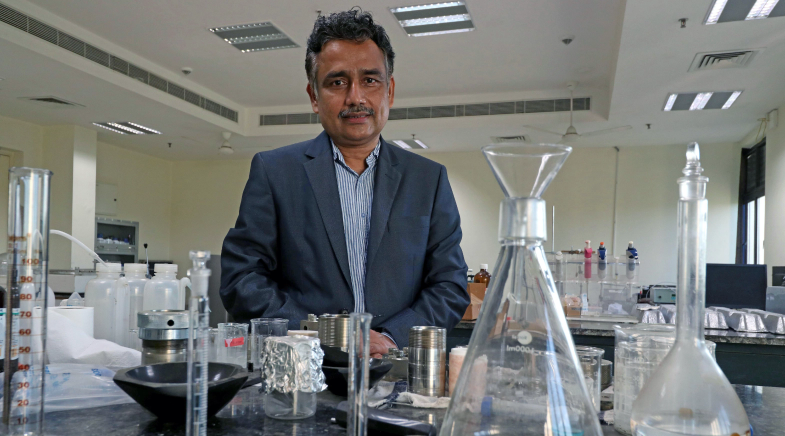Start-ups born on campuses
-
- from Shaastra :: vol 03 issue 11 :: Dec 2024 - Jan 2025

Start-ups are becoming an integral part of Indian universities, transforming faculty from researchers to solution providers for industry.
For a good part of the last decade, designing medicines at the nano scale had held the attention of M. Joyce Nirmala, Chief Scientific Officer at the Indian Institute of Technology (IIT) Madras. Medicines at the nano scale, where particle size is measured in billionths of a metre, are absorbed better and hence can work in lower dosages with reduced toxicity. In 2024, this research took the form of a start-up, SpiceC, designing anti-cancer drugs using a mixture of Indian spices.
Conventional drugs are made in micron sizes, measured at scales of millionths of a metre. Drugs at such sizes have poor solubility and permeability, and a substantial portion gets eliminated by our bodies. This means that a higher dose has to be administered, which increases the chances of toxicity. So, Nirmala has been developing drugs using a nano-emulsion technique with biocompatible oils extracted from plants and spices.
She needed steady funding to further her research and conduct clinical trials, and she realised that setting up a company was essential for her work to advance. While she was setting up the company, she was approached by companies to conduct a tech transfer. She had refused because she was not sure if they would take the risk of turning the nano spice extracts into a drug. "They might use it as a supplement or even market it as something else, say, a weight-loss drug – anything that will see profits sooner. But I am passionate about it reaching people with cancer," says Nirmala. Founding her own start-up was necessary to reach this goal.
As the Indian deep tech ecosystem develops, academic institutions are encouraging their researchers who are inclined towards entrepreneurship.
In engineering and several applied fields of science, research doesn't stop with a new finding and a paper. The old practice in universities was to license the technology to the private sector for continued research and then development. In the last few years, as they watch start-ups succeeding with regularity elsewhere, academicians are more ready to take the plunge. At the same time, as the Indian deep tech ecosystem develops, the country's academic institutions are encouraging their researchers who are inclined towards entrepreneurship. The result: premier educational institutions are turning out to be fertile grounds for the development of the next generation of tech start-ups.
CROSSING THE VALLEY OF DEATH
Researchers mark stages of technology against a scale called Technology Readiness Level (TRL). It starts at TRL 1, which marks a breakthrough in observation of the scientific principles behind the technology; it transitions to developing a proof-of-concept at TRL 3; and then to demonstrating the technology in a relevant environment at TRL 5; all the way up to scaling up and deploying the technology in real time, in operational environments, at TRL 9. It is at the TRL levels 4 to 7 that most research in universities get stuck, and does not translate into a product. Innovators call this the ‘valley of death'. In India, this valley was strewn with dead ideas from several academic institutions, as neither the researcher nor the private sector was willing to take the plunge.
Today, academia is looking at founding start-ups as a way to make it easier to bridge this valley. It explains why almost every department with applied potential in universities is building a start-up linked to its research. Prabhu Rajagopal, Professor in the Department of Mechanical Engineering at IIT Madras, says that the perception of entrepreneurship not being an activity suited to serious researchers has now been overturned. Now a majority of professors view it as a means to translate their research to the field. "We file IPs and write papers, but they're not really at the high TRLs required for the industry. In our labs, we can go up to a maximum of TRL 4," he says. The rest of the journey is one that neither the industry is willing to take up nor the government willing to fund. And that is where start-ups come in and become an integral part of their laboratories.
In India, the 'valley of death' is strewn with dead ideas from academic institutions: neither the researcher nor the private sector is willing to take the plunge.
At the Center for Non Destructive Evaluation (CNDE) at IIT Madras, Rajagopal has helped spawn about a dozen start-ups, including Solinas Integrity, a company that builds robotic septic tank cleaners. Since a majority of sanitary workers across the world lose their lives to asphyxiation during the cleaning of septic tanks, Solinas found a huge global market for a problem deep-rooted in India. Rajagopal believes that this is how deep tech start-ups are transforming the research landscape at universities. "The industry sees us as a solution provider rather than an innovation or idea provider," he says.
According to Nikhil Agarwal, Managing Director of the Foundation for Innovation and Technology Transfer (FITT) at IIT Delhi, faculty entrepreneurship has picked up in his institute. Since its establishment in 1992, FITT has been involved in knowledge transfer from the academia to industry. In 2023-24, over 20 of its incubated start-ups were faculty-led. As more professors dabble in founding start-ups, the nature of research at IITs has moved towards commercial potential. "Traditionally, not many Indian professors have worked in industry. They are what we call career professors, coming straight out of colleges to become teachers," says Agarwal. This gap between industry and the academia shrinks in an environment that fosters start-ups out of universities.

Santosh Gharpure, Professor-in-charge of IIT Bombay's incubator Society for Innovation and Entrepreneurship (SINE), says that inside laboratories, researchers may look at fundamental ideas from only one particular angle. But when these ideas are adopted into industry, they are challenged to expand their creativity – an aspect much valued in science – to turn the idea into a solution. "It's an immensely creative mindset that one needs to develop to explore beyond their standard boundaries of conventional research," says Gharpure, citing the example of ImmunoACT, a start-up incubated at SINE and founded by his colleague, Rahul Purwar. ImmunoACT has developed gene-modified cell therapies to treat diseases like leukaemia. Although it is a technology that is available in the Western world, a treatment regimen can cost up to half a million dollars and so remains out of reach for most people. "To bring that to India, the true innovation lay in making the technology affordable," says Gharpure. The company has so far brought its therapy to over 300 people.
A MARKET FOR GOOD IDEAS
For start-ups, the valley of death is not associated just with the TRLs. The technology might be mature, but the start-up may still fail to scale up in the absence of business acumen. "If you are starting a company based on some research that you have done in an academic institute, the most important thing to do is to get a CEO familiar with managing businesses," says Sunil Sherlekar, who was a faculty member in IIT Bombay when he co-founded SankhyaSutra Labs, which was acquired by Reliance Industries.
This kind of exposure to the industry helps researchers better understand what to do with their technology – to sell the patent, or to start a business with it. "If you have an early-stage idea which is still disruptive, then typically, a start-up is a good choice. You can take the technology to higher TRLs before selling it," says Rajagopal. Tech transfer also makes sense if the innovation brought by the research is incremental. Shaji Varghese, CEO of SINE, explains: "Say you have created an existing product with new material that reduces the cost by 10 to 15%. That's not enough to create a business. You would be better off selling it to manufacturers of that particular product."
Investors today understand that in academic start-ups, money that goes towards research and technology development is greater than that which is spent on customer acquisition. Where deep tech companies require a large amount of funding early in their existence, other companies need that later after they are established to be able to scale and build a huge marketing force. Moreover, typically, deep tech products borne out of academic research will probably be priced higher with a greater margin, and the volumes in which they are manufactured will be lower. However, the total amount of funding across their life cycle tends to remain the same, whether it is a non-deep tech or a deep tech start-up.

As more academic start-ups succeed, the next generation of students find more role models and become bolder with their technological ideas. They may not then default to moving abroad to join another country's workforce, a condition that plagues most of India's top universities. "Rather than being job seekers in other countries, they can become job creators here and impact the country's economy," says Gharpure. Adds Varghese, "Look at what Atomberg did with the ceiling fan." Incubated at SINE in 2011, Atomberg disrupted the ceiling fan market by replacing traditional AC induction motors with brushless DC motors that are quieter and use less energy.
Venture capitalists now have an eye on the research happening in universities, as it is a good way to discern high-value fields with a good future potential in deep tech. The STEM Cell at the Foundation for Science Innovation and Development (FSID), an incubator founded in collaboration with the Indian Institute of Science (IISc), Bengaluru, is always in search of research ideas that can be taken to the next stage. According to its Chairman C.S. Murali, the technology needs to be disruptive enough to not face competition for at least the next two years.
"We look at sectors such as sustainability – water treatment, for example. It is a problem that will persist for the next 20 years and can accommodate a large number of players who may apply different technologies to solve it," says Murali. Compare that with anything in pure software, the idea could look very interesting today and still get completely disrupted within two years. "That's why software companies succeed fast but can also fail fast. This is not true of deep tech companies with a hardware component in them."
THE RIGHT ENVIRONMENT
Of the above 100 start-ups that FSID incubates, roughly two-thirds are from educational and research institutions: either faculty commercialising their research output, or alumni who want to found start-ups after finishing their PhDs or Masters. Current policies permit the faculty to take some time off every week to devote towards their start-up, for advising students or leading the start-up. Some institutions also allow them to take a sabbatical year in building their start-ups and then go back to academics. Student entrepreneurs can write their exams despite not meeting the attendance mark. Their credits can instead be earned on the basis of how they develop their start-ups. "A decade ago, even the structure of a start-up was not very clear. So, there were no clear policies on whether professors could start a private entity," says Agarwal. "Today, even the university holds some equity in the start-ups as its labs and resources are being used for research and development."
Venture capitalists now have an eye on the research happening in universities, as it is a good way to discern high-value fields with a good future potential in deep tech.
A similar pattern of entrepreneurship emerged at IIT Bombay, once it started revising its start-up policies. SINE was established in 2004, and the number of start-ups that were founded in the past five years is more than double the number established in the first 10 years. In its 2024 revision, for example, the university states how researchers at IIT Bombay may license a technology IP generated at the institute, in return for royalty such as a percentage of the start-up's annual sales.
Having one foot in academia and the other in entrepreneurship may be a balancing act, but the fields also complement one another. The head of a research lab is a natural mentor and manager, qualities essential to running a team, and on a larger scale, a company. Academics also know the importance of marketing their work, to attract grants and win awards. "Academics are always in R&D mode, thinking about how to create something new," says Vijay Chandru, Co-founder and Chairman of Strand Life Sciences, and one of India's earliest academic entrepreneurs.
For Nirmala, one of the most important qualities she borrowed from academia is patience – to persevere in the development of a product, knowing that it might be several years before it starts seeing profits. The long gestation period of a deep tech start-up does not scare her, as long as it means that the drugs she designs reach the people who need them. "I have waited 10 years, I am willing to wait 10 more," she says.
With additional reporting by N. Ramakrishnan
See also:
Indian start-ups dive into deep tech phase
Fuel for take-off
Bridging the academia-industry gap
Support systems for start-ups
Space start-ups get into a higher orbit
Outlook positive
Chipping in
The rise of quantum.in
Automated growth
India is poised for a tech leap
Have a
story idea?
Tell us.
Do you have a recent research paper or an idea for a science/technology-themed article that you'd like to tell us about?
GET IN TOUCH














